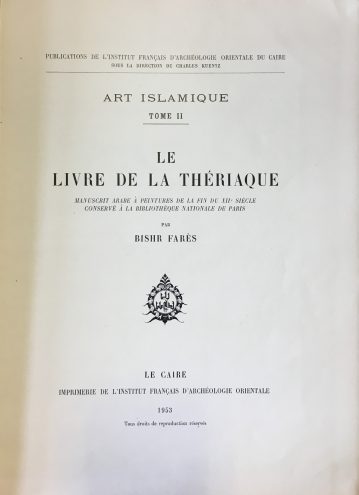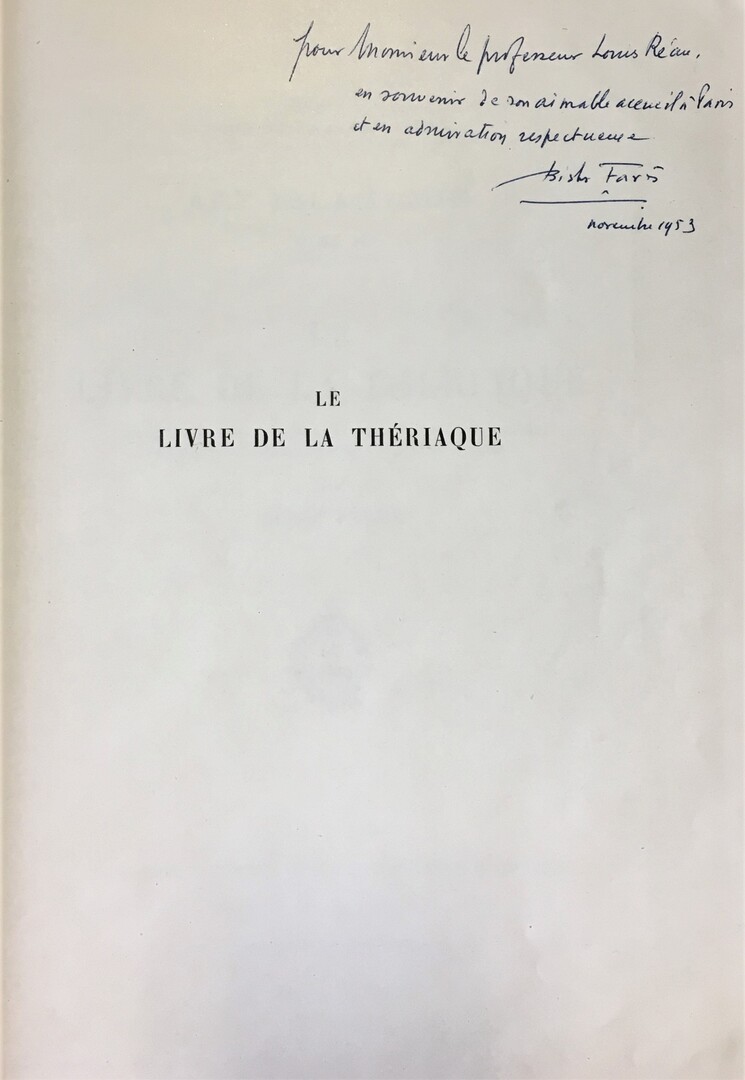Le Livre de la Theriaque. Manuscrit Arabe a Peintures de la Fin du XIIe Siecle Conserve a la Bibliotheque Nationale de Paris.
Fares, Bishr.
Synopsis
A presentation copy signed and dated by the author on half title page.
The Paris Kitab al-Diryaq manuscript, arabe 2964 at the Bibliothèque Nationale de Paris must have been an extraordinary work of art when it was completed in rabi‘ alawwal 595 A.H., January 1199 C.E., by “the weakest of the slaves of God,” as he calls himself in the colophon. His name is Muhammad ibn Abi al-Fath ‘Abd al-Wahid and he came from a family of pious and learned men, and somehow connected with the organization of the pilgrimage to Mekkah. As it exists today, the manuscript is incomplete and its remaining folios have been assembled into a book at a much later time without consideration for their original sequence. Nothing is said in the preserved folios about where the manuscript was copied, illustrated, and decorated. The sense of my observations suggests that the Kitab al-Diryaq was made for the private enjoyment of a learned religious and social leader who may not have cared much for the subjects depicted but who enjoyed the rich succession of beautiful pages offering surprise after surprise and who felt that a fancy pharmaceutical book is appropriate for his collection, perhaps because he was interested in popular science, but not necessarily so.
The whole manuscript is and was meant to be a work of art rather than a work of science or of learning. And we may be allowed to fantasize that some of the personages represented are dressed in the manner of members of a family or of a group, one of whom may have been bitten by a snake.
The greater quality of the writing when compared to the painting may well be the result of a longer experience with the practice of calligraphy than with the art of representation. This puts us in the realm of hypotheses. Where could a family or a group such as the one outlined here have existed? It has to have been a large city with an administrative and religious tradition, probably connected with the Iranian world, because of so many parallels with later Iranian examples of an urban art like that of ceramics, but also aware of the Byzantine-inspired Christian world which maintained the memory of learning and which could furnish examples of illustrated pseudo-scientific manuscripts. For these reasons, as has been proposed before, a city in the rich and tumultuous zone involving Azerbayjan, Western Iran, the Jazirah, even Iraq or Anatolia, may indeed be a preferred locale for the making and appreciation of this manuscript. But in the mercantile world of the time, when artisans and merchants moved easily and members of the same family settled in different cities of a Muslim cultural world in full expansion, the specific cultural milieu for this manuscript can in fact be imagined in many urban centers from Cairo in Egypt to Heart in Afghanistan.
The Paris Kitâb al-Diryâq. An Essay in Interpretation by Oleg Grabar].








